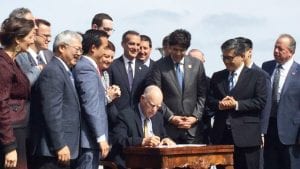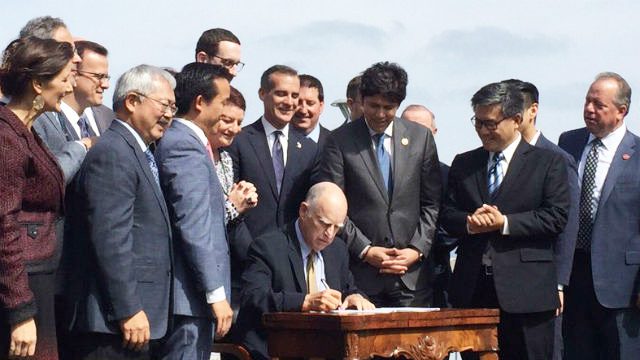
California Gov. Jerry Brown signs Senate Bill 2 in San Francisco. Photo courtesy of the Office of the Governor
At the close of the 2017 legislative session in September, California legislators passed 15 bills as part of a comprehensive housing package later signed by Gov. Jerry Brown. The historic legislative package includes a $4 billion bond measure to be placed on the 2018 ballot and a new fee on real estate transactions that will raise hundreds of millions for California’s Affordable Housing Trust Fund. The bills are a response to the state’s skyrocketing housing costs—three of the five most expensive housing markets in the country are in California.
Also, despite rapid job and population growth, the state is experiencing extremely low levels of housing production at all income levels. In addition, buried beneath bills that promise to add billions in funding for thousands of new affordable units were several legislative tweaks including a resounding victory for supporters of inclusionary housing.
The successful passage of AB 1505, known as the “Palmer Fix” bill, means that cities and counties in California once again have the full power of inclusionary housing at their disposal.
Legal Battles
In 2009, the California Court of Appeals pre-empted local inclusionary housing ordinances for rental construction when it sided with developer Geoff Palmer in Palmer v. City of Los Angeles. The courts agreed that Los Angeles’ inclusionary housing ordinance—which required Palmer to set aside 60 of 350 planned residential units for low-income residents or pay an in-lieu fee—violated the state’s Costa-Hawkins Act, which effectively bans rent control in new rental units. Since 2009, cities and counties in California have only enforced inclusionary housing ordinances in for-sale units.
Gov. Brown vetoed previous legislation that would have ensured Costa-Hawkins did not apply to local inclusionary housing requirements (AB 1229 from 2013), citing the pending California Supreme Court case California Building Industry Association v. City of San Jose in which developers attempted to challenge the legality of inclusionary housing ordinances in for-sale developments. In deciding that case in 2015, the state Supreme Court supported the legality of inclusionary housing (which Rick Jacobus wrote about in Shelterforce).
The court found that “the objectives of increasing the amount of affordable housing in the city … and of locating such housing in economically diverse developments are unquestionably constitutionally permissible purposes.” The court’s decision not only legitimized the goals of inclusionary housing but also removed any concern around legal barriers or potential future challenges to inclusionary housing ordinances in California. In 2017, Gov. Brown signed the “Palmer Fix” bill into law.
Local Power
Perhaps the most resounding effect of AB 1505 is that it is yet another blow to state pre-emption efforts. State governments across the country are increasingly stripping away power from municipal governments through legislation and court actions that block progressive local efforts to, for example, increase the minimum wage, protect local workers, or provide affordable housing. However, there is a bright spot: state and local advocates are successfully battling back against inclusionary housing pre-emption efforts.
Oregon was one of two states that prohibited inclusionary housing until 2016 when the state legislature reversed the state constitutional ban. Just this past year advocates in Louisiana blocked a swift attempt to reverse the state’s law that legalizes inclusionary housing in the state.
One challenge that advocates and policymakers seeking to enact municipal inclusionary housing policies face is the lack of legal clarity around whether state law allows such policies in a given state. Grounded Solutions Network will release a new map in early 2018 highlighting the legality of inclusionary housing by state based on legal research we’re conducting together with the Partnership for Working Families.
An Inclusionary Domino Effect?
The success of enabling legislation in California adds major momentum to the fight for inclusionary housing in the state and beyond. California is already one of the top three states for inclusionary housing programs, with at least 144 programs in towns, cities, and counties across the state. Now that inclusionary is fully legal in California, we expect the state to experience an increase in the number of communities that utilize inclusionary housing policies, as well as revisions to existing ordinances.
In the top two states with the most programs, Massachusetts and New Jersey, inclusionary housing has proliferated in large part due to supportive state legislation. As the nation’s largest state, California will serve as model for other states for how state government can make subtle changes to state law to ensure inclusionary policies are allowed within municipal housing toolkits. This victory in California is a national call to action.
It’s time for more states to do what it takes to pass enabling legislation for inclusionary housing, adding this valuable policy tool to the fight for more affordable housing opportunities.






Comments